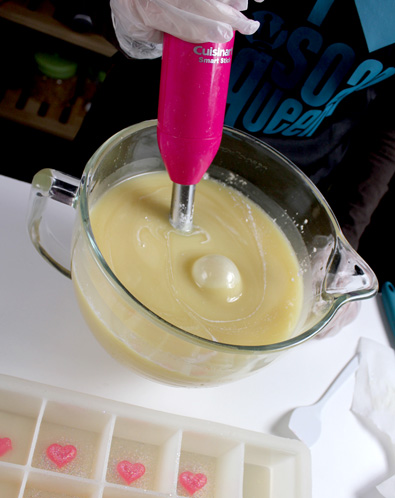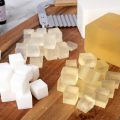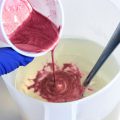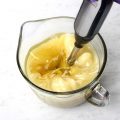Have you ever heard the term “burping your blender?” and then wondered what that means and how it applies to soapmaking? It’s a super easy trick that I do every time I make cold process soap that helps prevent air bubbles in your CP soap. Try it on your next batch. You won’t regret “burping”. I promise!

The cold process soap pictured above is a gorgeous combination of Brown Oxide, Yellow Oxide, Ultramarine Blue, Hydrate Chrome Green and Black Oxide. It’s scented with an earthy combination of Patchouli and Spearmint. There is just one problem…those darn air bubbles! Either the trace was too thick when it was poured or (cough cough) ‘someone‘ didn’t burp their stick blender. Here’s how you burp your stick blender to avoid those pesky bubbles in your soap.
Burping: Before you turn the stick blender on to mix the oils and lye together, gently tap the stick blender on the bottom of the of your container until you see all of the air bubbles come out. Do you see that big air bubble below? You’ll be glad you didn’t whip that air into your soap when you cut the final bars.
 Check out that monster air bubble surfacing!
Check out that monster air bubble surfacing!
Other Tricks: When combining my oils and lye I also like to pour the lye down the side of my stick blender. By letting the lye run down the side of the blender, you eliminate any splashes that could cause air bubbles. Kat from Otion also suggest keeping your temperatures on the lower side. She finds that super hot soap can cause the soap to bubble a little bit. Check out the lye and burping tricks in this episode of Soap Queen TV (you can fast forward to minute 3:50 to see the action). And if you have never made cold process soap, check out the series for beginners here!
How do you avoid air bubbles? Do you have any other ideas?





The main type of fat found in all kinds of olive oil is monounsaturated fatty acids (MUFAs). MUFAs are actually considered a healthy dietary fat. If your diet emphasizes unsaturated fats, such as MUFAs and polyunsaturated fats (PUFAs), instead of saturated fats and trans fats, you may gain certain health benefits. .,*;
Please do look out for our favorite web blog <http://www.healthdigest101.com
Hello!
I have just started making cold-processed soap. I started off doing the basic olive oil soap from the Natural Chef Soap book. It calls for 567 grams of olive oil, 73 grams of lye, and 215 grams of distilled water. When I began blending it with my hand blender, I was doing it for about 20-30 minutes and my soap still wouldn’t trace. The temperature was just right (110 to both mixes), so I don’t know what else could’ve went wrong. It was still too watery, so I continued the rest of the recipe and finished it off like I normally would. Please help!
-desperate soapmaker
Hi Brissa!
When you were blending it, were you using a hand blender or stick blender? When mixing soap, you are going to want to use a stick blender vs. a hand blender.
https://www.brambleberry.com/Perfect-Pink-Stick-Blender-P5245.aspx
And, the basic olive oil soap is going to be naturally a bit more ‘watery’ so you might actually need to blend it for longer than a typical recipe with Coconut and Palm. I hope this helps. 🙂
-Becky with Bramble Berry
I noticed yesturday for the first time when I combined just my oils(before the lye) that I had lots of little air bubbles. I was stumped. I just started using a new pail of palm oil and wondered if it had something to do with it. Any thoughts?
Sometimes oils will naturally get air bubbles in them, did your previous pail of palm oil have air bubbles like the current one does?
The air bubbles aren’t going to harm your oil (or soap), and the best way to get rid of them is to “burp” your blender when you are mixing. You can also bang the bowl while it is still being mixed to get rid of some of those pesky little air bubbles!
I hope this helps, let me know how it turns out!
-Becky with Bramble Berry
I like to tip my stick blender as I put it in the oils. The blender bit has slots around the edge, and by tipping it I end up with a much smaller air bubble on the bottom. Then I tap to get the little bubble up.
Thanks for the great tip, Allie, I’ll definitely pass that on!
-Becky with Bramble Berry
Is it a good idea to do this when using a stick blender to make lotion? I noticed sometimes my lotion is a little foamy on top when I am ready to cap the bottles 🙂
Absolutely! You always want to try to avoid air bubbles and whenever you use a stick blender, you want to “burp” it before you blend!
-Becky with Bramble Berry
I never heard of burping a blender until you showed it in a video. Great idea. I love the look of smooth air bubble free soap. I just got the pink blender from Bramble Berry for Mother’s Day. Now I know how to burp it.
I burp the blender but always get lots of air into the batter anyway. Like Cassandra, I bang the mold a few times, but I also gently bang the bowl while it’s still being mixed, and hand stir (with the blender) just before pouring; the combination has mostly gotten rid of the air holes. For uncoloured or all-one-colour soap, you can drag a spatula through the soap (in the mold), back and forth, and that helps a ton too!
I usually tap my soap filled molds on d table a few times to eliminate d air bubbles. I’ve been making my wonderful goats milk soaps with fresh goats milk from our own herd of goats without air bubbles for 4 years now.
What a great tip, thank you for sharing that with us. Sometimes those little air bubbles are tricky, so any tip to get them out of our soap, we’ll take! 🙂
-Becky with Bramble Berry